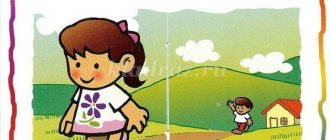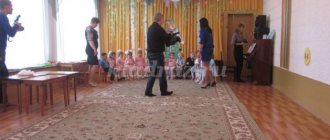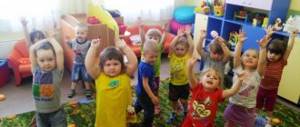Planning of regime moments in preschool educational institutions
Summary of a routine moment for children of the middle group (4-5 years old) on the topic : “Preparing for lunch, serving in the canteen, lunch.”
Educational objectives : – form the habit of washing yourself, washing your hands with soap before eating, following a certain sequence of actions; – improve the skills of careful eating: the ability to take food little by little, chew well, eat quietly, use cutlery and napkins correctly, rinse your mouth after eating; – continue to teach children to independently perform the duties of cafeteria attendants: carefully arrange bread bins, napkin holders, cups, deep plates, cutlery; – clarify and expand the vocabulary on the topic “Utensils”; – improve the grammatical structure of speech. Developmental tasks: develop: – memory, attention, thinking, speech; – independence in performing cultural and hygienic skills and work activities. Educational tasks: to educate: – the ability to calmly wait for the next dish to be served; – politeness (the ability to thank for food), the need for cleanliness and neatness. Vocabulary work: activation - deep plate, shallow plate, cup, napkin holder, spoons, forks. enrichment – cutlery, serving, bread box. Methodological techniques for organizing routine moments: 1. Verbal: reminders, instructions, explanations, encouragement, conversation, questions. 2. Visual: personal hygiene products, serving utensils. 3. Practical: hand washing, labor actions of those on duty. Equipment: soap, towels for each child, tablecloth, cutlery (spoons, forks), tableware (deep plate, shallow plate, cup, bread box), napkin holders, napkins, mouthwash cups (for each child.) Preliminary work: – Examination of dishes; – Guessing and learning riddles about dishes; – Learning nursery rhymes and proverbs; – Reading a fairy tale: K. Chukovsky “Fedorino's grief”; – Didactic game: “Big - small”, “Which dishes are hidden?” Progress of the regime moment: Children come from a walk, change clothes, go to the washroom. Organize hygiene procedures after a walk gradually, in small groups of children. Remind children of the rules of behavior in the washroom - children should not splash water, should maintain order and cleanliness, immediately turn off the water after washing their hands, and do not leave taps open. I remind you of the rules of washing: Educator: Let's tell you how to wash your hands correctly. • roll up our sleeves • open the water tap • wet our hands with water • take soap in our hands • lather until thick foam • rinse off the soap thoroughly with water • wring out our hands with a “lock” • turn off the water tap • wipe our hands dry from the water with your towel • lower your sleeves. Educator: So as not to be afraid of germs, you need to wash your face often. Wash your palms only with soap, so that you always have health. These procedures should be carried out in a calm, friendly environment, which will ensure a good mood for children while eating. Those on duty are among the first to wash their hands; They put on aprons and caps and, under the guidance of the assistant teacher, set the table. The children leave the washroom. Educator : What did we do now? Children : Wash your hands. Educator : Why do you need to wash your hands? (Children's answers) All diseases in children are caused by germs, they say. To always be healthy. You need to wash your hands with soap! Educator: While our attendants are setting the table, you and I will play . Game “Riddles” 1. I puff, puff, puff - I don’t want to get warm anymore. The lid rang loudly - Drink tea! - The water has boiled! (Teapot) 2. A boat is floating on my plate. I send the boat with food into my mouth. (Spoon) 3. If sharpened well, it cuts everything very easily - Bread, potatoes, beets, meat, Fish, apples and butter. (Knife) 4. It can be deep. It can be small. However, this is not a river. (Plate) 5. The teapot's friend has two ears, cooks porridge and soup for Yulia. And her name is... (Castle) 6. Among spoons, I am a colonel. And my name is... (Ladle) 7. The round-eared sister will give you some tea to drink. (Cup) Didactic game “Big - small” Plate - plate Jar ... Cup - cup Bucket ... Saucer ... Jug ... Saucepan ... Decanter ... Frying pan ... Mug ... Tray ... Vase ... Teapot ... Bowl ... Educator: How can you call these objects, one in a word? (Dishes.) Here is a large glass teapot. Very important, like a boss. (They puff out their cheeks, legs shoulder-width apart, hands on their belts.)
Here are the porcelain cups. Very fragile, poor things.
(They squat, their right hand is on their belt, their left is lowered.)
Here are the porcelain saucers. Just knock, they will break.
(Hands to the sides, spinning in place.)
Here are silver spoons,
(Standing still, hands clasped above your head.)
Here is a plastic tray He brought us the dishes.
(They hold hands and make a circle.) Finger gymnastics. One, two, three, four - we washed the dishes: a teapot, a cup, a ladle, a spoon, and a large ladle.
We washed the dishes: The cup was not even broken, the ladle was not broken either, the nose of the teapot remained. The spoon miraculously survived. We wash the dishes safely. When the table is set, the attendants approach the children and announce the menu. Torque design table
walk
| № | Structural components of the regime moment | Activities | Tasks | Forms, methods, techniques | Planned results (child's achievements) |
| 1 | Organization of walks | Developing independence in following the rules of getting ready for a walk. | Form ideas about the rules for getting ready for a walk, develop the ability to independently perform actions provided for by the rules: - to restore order in the group and development centers (put away toys and aids, carefully and beautifully place chairs at tables) (“Cognition”, “Labor”, “Socialization”, “Safety”, “Artistic creativity”); -visit the toilet, wash your hands after using the toilet (“Health”, “Socialization”); - dress according to the weather, in a certain sequence, carefully, in a general rhythm, without disturbing your neighbors (“Health”, “Socialization”, “Safety”, “Cognition”); -if necessary, ask for help, provide assistance to peers (“Communication”, “Socialization”); -after dressing, carefully close the locker door and wait for other children (“Safety”, “Labor”, “Socialization”); -participate in the preparation and removal of material necessary for the walk (“Communication”, “Socialization”, “Labor”); - calmly go for a walk, hold the door when closing, take care of the safety of peers (“Safety”, “Health”, “Communication”, “Socialization”, “Labor”). | Reminder, situational conversation, support, positive assessment, encouragement, help, asking a child to help a peer, an example of ethically valuable behavior towards each other, praise - approval, the teacher expressing his feelings related to the children’s display of neatness and accuracy , as well as goodwill, desire to help, voicing children’s feelings, telling stories, reciting nursery rhymes, poems, riddles. | The child is neat, tidy, takes care of the condition of things and clothes, and keeps the locker and dressing room in order. The child is attentive to the needs and requirements of those around him, is able to turn to peers with a request for help in a friendly, benevolent manner, respond kindly to a request, and provide help on his own initiative. |
Duty duty moment design table
| № | Structural components of the regime moment | Activities | Tasks | Forms, methods, techniques | Planned results (child's achievements) |
| 1 | Catering organizations | Formation of ideas about duty as a manifestation of care for other people. Development of skills to prepare the dining area for meals. | To form ideas about preparation for canteen duty (cultural and hygienic skills, appearance) (“Health”, “Socialization”). Develop ideas about the need to comply with safety rules when preparing tables and chairs, as well as setting tables for meals (“Cognition”, “Safety”). Form ideas about the menu, etiquette forms of table setting in accordance with the menu, develop the skills to correctly and beautifully set the dinner table (“Cognition”, “Labor”, “Safety”, “Socialization”). Develop mathematical and constructive abilities (counting skills, maintaining symmetry in the organization of table space) (“Cognition”). Create a sense of responsibility for preparing the dining area for meals (“Socialization”). | Actions according to verbal instructions, sample, instructions and tasks, positive pedagogical assessment. | The child understands the importance of his work for others and shows concern for his peers. The child is capable of self-control and shows responsibility for creating a favorable environment for eating. |
Torque design table
meal
| № | Structural components of the regime moment | Activities | Tasks | Forms, methods, techniques | Planned results (child's achievements) |
| 1 | Catering organizations | Formation of a nutrition culture. | To form children’s ideas about the need for calm, leisurely eating and chewing food thoroughly (“Health”, “Safety”). Develop ideas about the usefulness of dishes, the technology of their preparation, the influence of nutrition on the physical condition and health of a person (“Cognition”, “Health”, Physical Culture”); about etiquette norms and rules of behavior at the table (“Cognition”, “Socialization”). Develop skills of safe and cultural behavior during meals (“Safety”, “Socialization”, “Communication”). Develop the ability to notice the beauty of table setting, presentation of dishes, appearance (of the duty officer, assistant teacher, children), the ability to maintain order on the table (“Socialization”, “Labor”). To form a feeling of gratitude to the cook, assistant teacher, laundry operator, duty officer (“Socialization”, “Labor”). | Menu presentation, message, expression of positive emotions, positive pedagogical assessment, situational conversation. | The child understands the need to perform cultural and hygienic procedures and controls the quality of self-care. The child demonstrates cultural behavior skills during meals and maintains order on the table. The child actively shows attention, a sense of gratitude and appreciation for the work of peers and adults. |
Torque design table
dream
| № | Structural components of the regime moment | Activities | Tasks | Forms, methods, techniques | Planned results (child's achievements) |
| 1 | Sleep organization | Creating individual comfort for children in bed, showing concern for their emotional well-being during sleep. Forming a caring attitude towards a sleeping person. | Develop the ability to take a comfortable position and relax in bed (“Health”, “Physical Education”). Develop ideas about the possible causes of awakening (thirst, vital needs, sensations of cold or heat, a bad dream, the end of a period of sleep), adequate behavior in case of sudden awakening (“Cognition”, “Socialization”). Develop the ability to independently satisfy your needs (go to the toilet, drink water, take cover if you are cold) in moments of sudden awakening (“Health”, “Socialization”). Form ideas about the rules of behavior in case of sudden awakening, develop the ability to behave quietly, showing respect for the sleep of peers (“Health”, “Socialization”, “Cognition”) | Music therapy, individual assistance in achieving a comfortable state in bed, fairy tale therapy, reading fiction, situational conversation, questions and assumptions (Are you cold? Do you want to go to the toilet? Did you have a bad dream?), reciting actions, positive assessment. | The child behaves quietly and calmly in the bedroom and independently satisfies his needs upon sudden awakening. Annual design of routine moments frees the teacher from the need for daily planning of those tasks that are solved in the conditions of organizing a daily routine, regardless of the season or event (education of cultural and hygienic skills, table manners, development of the ability to dress in a certain sequence, follow the rules of behavior in the washroom and so on.). |
Conversation with children in the middle group in the morning: planning features
Mornings in kindergarten are often a little hectic.
What should educators do in this case? Calm the children down! A meaningful and at the same time light conversation with children in the middle group in the morning, for example, will be an excellent assistant in this. The main thing is for the teacher to prepare for it properly.
To do this, he must be perfectly familiar with the patterns of psychophysiological development of children, with training programs, with techniques and methods of education and training.
So how does this all happen? First, the teacher needs to figure out how to plan short conversations with a group of children in the morning. That is, what goals will be set, what rules and sequence of actions will be developed, what results are expected.
In a word, the plan of conversations in the middle group is a condition for the organization of work and purposefulness of the teacher, protection from gravity, from missing any significant development tasks. The most important thing is to try to evenly distribute the program material throughout the year, avoiding haste and overload, and consolidate it in a timely manner.
How to plan the topics of conversations?
So where to start? Firstly, in every modern preschool educational institution there should be a file of conversations with children in the morning in the middle group. This significantly facilitates the teacher’s work, being a necessary condition for successful work with children.
As a rule, conversation plans are arranged in alphabetical order by content. This makes it much more convenient to search for exactly what you need. The topic can be very different: seasons, holidays, and rules of cultural behavior. Much, of course, depends on the approved program.
But exactly how the conversation will be conducted depends on the teacher.
And one moment. Both teachers working in the same age group draw up conversation plans. By fulfilling this condition, they have a unified approach to children and uniform requirements for them.
Shift teachers must have daily contact at work, constantly share their opinions on the results of observing children after conversations with them: how the material was learned, how the little ones perform their duties, what skills of cultural behavior they have learned.






